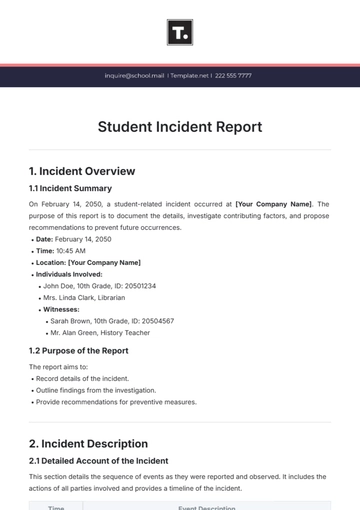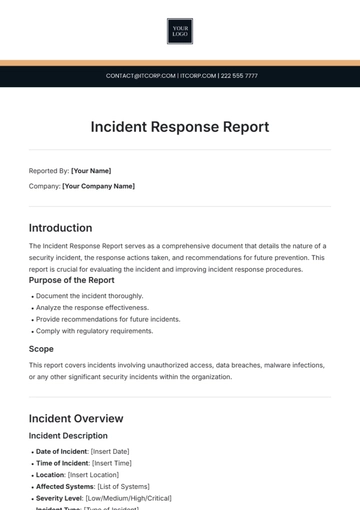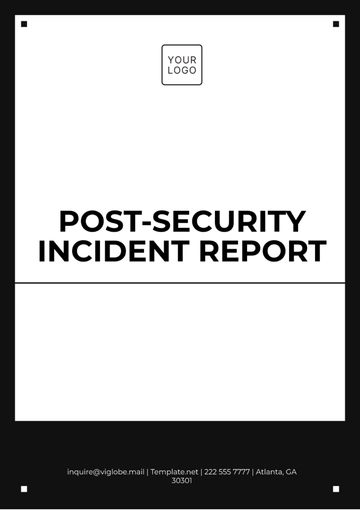Free HIPAA Incident Report

I. Introduction
[Your Company Name], prioritizes stringent data security and patient confidentiality. This HIPAA Incident Report details an unauthorized access attempt to our electronic health records (EHR) database on May 15, 2051. Through transparent documentation and adherence to response protocols, we strive to maintain accountability, protect patient trust, and ensure compliance with HIPAA standards.
II. Incident Details
Incident Date: May 15, 2051
Location of Incident: [Your Company Address]
Description of Incident
On May 15, 2051, at approximately 10:35 AM, our automated security monitoring system detected unauthorized access attempts within our electronic health records (EHR) database. Further investigation revealed that the breach stemmed from the credentials of a former employee, Jake Robertson, who had retained access privileges beyond his termination date. Mr. Robertson attempted to access patient records from a remote location using his previous login credentials. Fortunately, our robust security protocols immediately flagged this activity, prompting an immediate response from our IT security team.
III. Persons Involved
Number of Individuals Affected: 387 patients
Details of Affected Individuals:
The affected individuals encompass patients who have sought medical services at [Your Company Name] within the last six months. This includes individuals undergoing routine check-ups, specialized treatments, and consultations across various medical departments within our facility.
IV. Information Potentially Compromised
Type of Information Involved:
The potentially compromised information consists of personal identifiers (full names, addresses, dates of birth), detailed medical histories, treatment plans, medication records, and insurance details.
The extent of Potential Exposure:
While the breach was swiftly identified and contained, it is plausible that Mr. Robertson accessed patient records containing sensitive health information. However, there is no evidence to suggest that any information was copied or disseminated beyond the initial access attempt.
V. Detection and Response
How the Incident Was Detected:
The breach was detected through our sophisticated anomaly detection software, which continuously monitors access logs for unusual patterns or activities. Once the unauthorized access attempt was identified, automated alerts were triggered, prompting an immediate investigation by our IT security team.
Immediate Actions Taken:
Upon detection, we promptly disabled Mr. Robertson's access credentials and isolated the affected sections of the database to prevent any further unauthorized access. Simultaneously, our incident response team initiated a thorough investigation to assess the extent of the breach and mitigate potential risks to patient data.
VI. Notifications and Communications
Internal Notifications:
Internal notifications were disseminated to senior management, the IT security team, and legal counsel via email and in-person meetings on May 15, 2051.
External Notifications:
External notifications were issued to the affected patients via certified mail on May 18, 2051, adhering to the stringent notification requirements mandated by HIPAA regulations. Furthermore, the incident was promptly reported to the Department of Health and Human Services (HHS) Office for Civil Rights (OCR) on the same day.
VII. Investigation Details
Investigation Team:
The investigation was spearheaded by our IT security team, comprising cybersecurity experts, forensic analysts, and legal counsel, with oversight from senior management.
Investigation Findings:
The investigation conclusively determined that the breach occurred due to the retention of access credentials by the former employee, Mr. Robertson, following his termination. It underscored the critical importance of implementing robust access control measures and conducting regular audits to mitigate such risks effectively.
VIII. Corrective and Preventive Actions
Corrective Actions Taken:
Immediate corrective measures included resetting all user credentials, implementing enhanced access control protocols, and reinforcing employee training on data security best practices. Additionally, a comprehensive review of access logs was conducted to identify and address any further potential vulnerabilities.
Preventive Actions Implemented:
To fortify our defenses against future incidents, we have implemented stringent access control policies, including regular audits of user access privileges and mandatory password rotations. Furthermore, we are enhancing employee training programs to heighten awareness of data security protocols and foster a culture of vigilance across our organization.
IX. Approval

[Your Name]
Senior Compliance Officer
[Date]

David Smith
Chief Information Officer
[Date]
- 100% Customizable, free editor
- Access 1 Million+ Templates, photo’s & graphics
- Download or share as a template
- Click and replace photos, graphics, text, backgrounds
- Resize, crop, AI write & more
- Access advanced editor
Stay compliant with Template.net’s HIPAA Incident Report Template. This customizable and editable template allows precise documentation of incidents, safeguarding patient information. Editable in our AI Editor Tool for effortless and secure updates.
You may also like
- Sales Report
- Daily Report
- Project Report
- Business Report
- Weekly Report
- Incident Report
- Annual Report
- Report Layout
- Report Design
- Progress Report
- Marketing Report
- Company Report
- Monthly Report
- Audit Report
- Status Report
- School Report
- Reports Hr
- Management Report
- Project Status Report
- Handover Report
- Health And Safety Report
- Restaurant Report
- Construction Report
- Research Report
- Evaluation Report
- Investigation Report
- Employee Report
- Advertising Report
- Weekly Status Report
- Project Management Report
- Finance Report
- Service Report
- Technical Report
- Meeting Report
- Quarterly Report
- Inspection Report
- Medical Report
- Test Report
- Summary Report
- Inventory Report
- Valuation Report
- Operations Report
- Payroll Report
- Training Report
- Job Report
- Case Report
- Performance Report
- Board Report
- Internal Audit Report
- Student Report
- Monthly Management Report
- Small Business Report
- Accident Report
- Call Center Report
- Activity Report
- IT and Software Report
- Internship Report
- Visit Report
- Product Report
- Book Report
- Property Report
- Recruitment Report
- University Report
- Event Report
- SEO Report
- Conference Report
- Narrative Report
- Nursing Home Report
- Preschool Report
- Call Report
- Customer Report
- Employee Incident Report
- Accomplishment Report
- Social Media Report
- Work From Home Report
- Security Report
- Damage Report
- Quality Report
- Internal Report
- Nurse Report
- Real Estate Report
- Hotel Report
- Equipment Report
- Credit Report
- Field Report
- Non Profit Report
- Maintenance Report
- News Report
- Survey Report
- Executive Report
- Law Firm Report
- Advertising Agency Report
- Interior Design Report
- Travel Agency Report
- Stock Report
- Salon Report
- Bug Report
- Workplace Report
- Action Report
- Investor Report
- Cleaning Services Report
- Consulting Report
- Freelancer Report
- Site Visit Report
- Trip Report
- Classroom Observation Report
- Vehicle Report
- Final Report
- Software Report





























